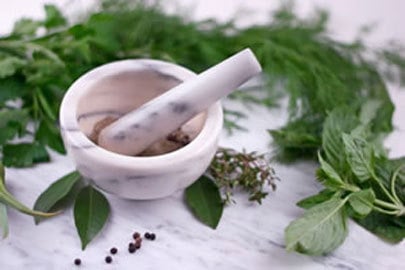Using Herbs Wisely
Today I want to share a little general wisdom about herbs; their strengths and proper applications for animals, and how readers who are interested in herbs, can sort through the ocean of information (and misinformation) regarding their use. Some of the things I see online and hear from members of my Facebook group and from clients, do alarm me. Recently I read an article on a popular magazine, describing how one can use herbs as nutritional supplements. Now, the first thing that struck me there was, how bizarre that a magazine which takes a hardline raw/prey model stance would be promoting herbs as nutritional support, when they are generally opposed to any form of vegetables (much safer sources of nutrient overall). In truth, when it comes to dogs, herbs are NOT good nutrient-suppliers for two reasons: to start, they do contain vitamins and minerals of course, but they also supply medicinal actions and so if you feed them in the amount required to make any sort of nutritional difference, you are also potentially feeding high levels of these medicinal constituents . Some herbs are known as “food plants” and you can in fact, feed a generous amount of them – others are very high in tannins, oxalates or salicylates, and some are what we call “low dose” herbs, meaning only small amounts should be given due to the presence of strong alkaloids that can have potent actions in the body. In addition, nutrients from plants are not as well utilized by dogs as are those from animal products, so while I rely a little on plant foods for nutrient in a recipe, I rely much more on veggies for compounds that support health, such as antioxidants. And veggies or fruit are a safe and more reliable way to go about this, by far. You can feed a great deal more of them safely than you can, say, comfrey or lobelia (believe it or not, these were recently mentioned in an article about using herbs for nutrition, for dogs). If using lobelia as a source of manganese, as was suggested, you’d have a very sick, vomiting dog long before you met the RA, which can be easily met with foods like kale, chickpeas, zucchini, sweet potato and pumpkin seeds.

Cloves, cinnamon, green and black tea and pineapple are all foods with high levels of manganese, a mineral your dog requires in small amounts, but that is important for bone development, reproduction, and plays an essential role in nutrient metabolism. Obviously, there are better choices for supplying manganese in the canine diet…
So, one thing to know about herbs as you embark on this journey; they’re not great sources of essential nutrient at all for dogs. Second thing is, they ARE incredibly useful used in small amounts as tonics, for antioxidant support, or in stronger, more medicinal form to both support overall health and target specific illness. You just need to know where to start.
Many of the herbs I see promoted (relentlessly) are indeed medicinally very useful – Curcumin longa(turmeric) comes to mind right away, but Silybum marianum (Milk thistle), Echinacea spp, Chamomile, Devil’s Claw, Slippery elm and more are all presented commercially as substitutes for pharmaceuticals, and then much focus is given to them as though they are the only or the best choices for whatever it is you are hoping to treat (anxiety, liver disease, infection, cancer). Herbs of Commerce, as these are known, are often over-prescribed and sometimes, harvested from the wild to the point of near-extinction. Slippery elm is now endangered, as is Goldenseal – and while they are both fantastic herbs for specific conditions, like the others listed above, there are many great alternatives.
United Plant Savers is a great resource for learning more about at-risk herbs and some alternatives as well: https://www.unitedplantsavers.org/species-at-risk
My bottomline with learning about herbs for dogs is, take it seriously! When misinformation becomes outright dangerous, I feel a need to speak up. Articles on herbs should be written by herbalists – and one hallmark of a reliable herbalist is, we don’t recommend the use of the same herb over and over, or herbs allopathically unless it is a first aid situation. Your dog has a history and a unique constitution and metabolism, so the type of herbs used, the form in which they’re given and the dose, are all going to be vastly more effective if put together with care, not doled out generically as in “here, take this cinnamon”. Be wary, too, of sites that rattle off long lists of what a herb is supposedly “good for” without a proper monograph that includes the Latin name, family, parts used, actions, energetics, constituents and possible contraindications, as well as personal experience in usage. You may have enough interest in the topic to take a basic course or invest in a few herbals yourself, or you may find good sites and blogs to follow(there are many) and learn on your own. You may find a herbalist closeby who will treat animals or you might schedule an appointment for yourself (or both!). At a minimum, be wary of sensationalism and be sure that when an article appears in your mailbox about herbs, it is actually written by a herbalist. I love to see people using plants wisely for their animals as well as human family, but when in doubt, dig a little deeper. If you fed enough comfrey to try and supply iron to an anemic dog,another suggestion I saw recently, you would seriously compromise his liver. Herbs are potent and need to be addressed with respect and wisdom. I hope my blog and the new course, the FB Page and group, will be of much assistance on your journey of learning.
Used wisely, the plants are the greatest of allies and helpers…but natural does not always mean safe. When in doubt, trust a herbalist.

~*~ ~*~ ~*~ ~*~ ~*~ ~*~








How would we know if someone is a legitimate herbalist? Is there some kind of certification?
Hi Cindy,
Sorry for the late reply, I was offline for about week, with computer issues, so I’m very backed up now. It’s a great question and one that isn’t easy to address. The first answer is that yes, there are some credentials to look for, and I can share some of those, but the tricky part is, the presence of those credentials doesn’t always ensure a skilled practitioner (just like there are great vets, average vets and not-so-good ones, or any profession for that matter) a course of study completed and some initials don’t guarantee excellence at all. To further complicate matters, some of the very best herbalists I know don’t have those certifications. So how does one decide?
Well, I see it like this. First, reputation. If someone has a longstanding career, internet presence, runs a good website, teaches etc, has been in clinical practise a long time – that’s a good indicator. Education may be a helpful indicator too(bearing n mind that many fine herbalists are self taught). Once you understand the language of herbalism a bit, you can spot the kind of writing that indicates knowledge and distinguish it from the dilettante who lists of “what a herb is good for”. Because there is so much to say about this question, I’ll devote a blog entry to it myself in future.The bottom line is…is this person experienced? Educated? What kind of following do they have? Is herbalism something they’ve kind of tacked onto another, deeper calling, such as training/behaviour(with a little herbalism on the side) or have they invested deeply in their knowledge? Do they post real monographs of herbs, or just list off the conditions a plant is used for? These aspects are IMO, more important than “certification”. But you can always check the American herbalist Guild, for example, for a list of practitioners who have achieved the RH (Registered herbalist) designation.
Please check back for an update (entry) on this important issue, soon.
There is Yarrow weed ( does not flower) that is growing from my neighbors yard and grows into my yard from in between our fences. My dog eats the grass along that side of the fence and has been also eating the yarrow weed that is growing in with the grass. We had no idea that this has been the reason she gets sick every new spring, but after our neighbor pointed out to us that this Yarrow could be causing her to become sick, and that Yarrow weed is toxic to dogs. My Labrador is 8 years old and has had experienced excessive drooling, upset stomach ( GI issues ) every spring and sometimes summer for about the past 4 to 5 years, and she now is loosing her fur excessively. We have been taking her to the vet for treatment for these symptoms every year now for these past 4 to 5 years and they never have answers for me, they just make me feel like I’m worrying too much. This winter was the first time my dog started to show a serious health condition, she started to excessively shed, and have bald patches under her belly, hind legs and arm pits. Our vet gave us a herbal called Eight gentlemen, and melatonin to put her on. Well this combination cleared up all her issues, she seemed young again, her coat grew back beautifully and soft, her chronic limp even went away . Then spring came, and that is when we found out what might have been causing all her health issues. She stared eating the grass again along the fence where the yarrow weed grows, and all of her symptoms started all over again: GI upset, excessive hair loss (bald patches), and excessive drooling after she’s eaten the yarrow. I have read on other sites, ASPCA’s website that this Yarrow weed can cause all these symptoms, and health problems in dogs. When I told this to our vet she acted like I was crazy, and told me no this is not the case. My question is do you have any advice as to how i can help my dog regain her health, and if you have ever seen this Yarrow be this toxic to dogs before. We have dug out all the grass and yarrow weed so she no longer can eat this. If you have any answers or advice on this please let me know. My dog is my everything, and i just want to help her get back to health and live a great life with us.
Sincerely,
Tracey Samenook
Hi Tracey…well, a few things. yarrow is not actually toxic to dogs, i use it internally all the time. It is, however, a member of the Asteraceae family – thousands of plants in that family so we do see a few allergic reactions. I am personally very allergic to yarrow, I break out in hives if I even handle it. Your dog’s drooling after eating the plant you think is yarrow might simply be a bit of a topical allergic reaction. If the plant your dog consumes never flowers, it’s not yarrow, which is a flowering plant – it would help a lot if you had a picture of your weed?
I might consider having a full panel thyroid done for your dog – see my article on that topic – and as always, I’d need the nutritional history to see if anything you feed 9or don;t feed) might be playing a role here too.